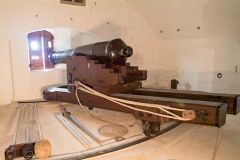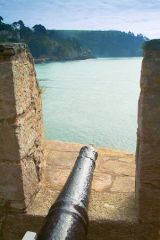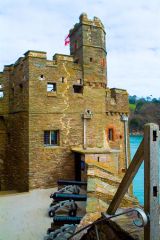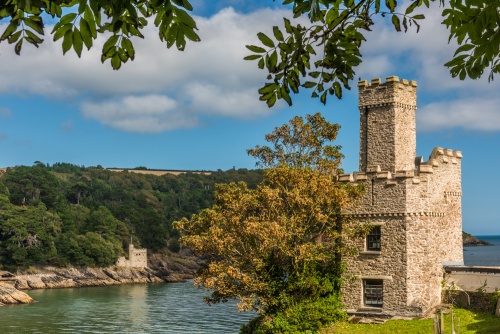
Dartmouth Castle is a Tudor artillery fort at the head of the River Dart, built to defend the important port of Dartmouth. The castle was built after Edward IV offered £30 a year 'for ever' to the town burgesses if they would erect a 'tower with a chain sufficient in length and strength to stretch across the mouth of the haven'. The burgesses agreed to the bargain and proceeded to create the first English castle built with artillery in mind.
History
The first castle was begun in 1388 during the Hundred Years War, England's interminable on-again, off-again war with France. Dartmouth was an important port and a centre for the wine and cloth trade. It was also the home port for merchant adventurers; bands of sailors sometimes working for the king but more often simply bent on plunder, who captured French ships on the high seas and raided towns along the French coast.
The French, not surprisingly, retaliated, and Dartmouth was a natural target for their raids.
Richard II was not willing to spend royal funds on the defence of Dartmouth but he urged the town's mayor, John Hawley, to strengthen Dartmouth's defences from attack. Hawley's response was to begin building a fortalice (a small castle) at the head of the River Dart. This fortalice was the first step in the development of Dartmouth Castle.
The fortalice was defended by high walls and a deep ditch. Inside the walls was the ancient chapel of St Petrox. It seems likely that the fortalice included space for catapults. There was no permanent garrison; the fortalice was only manned during times of threatened invasion.
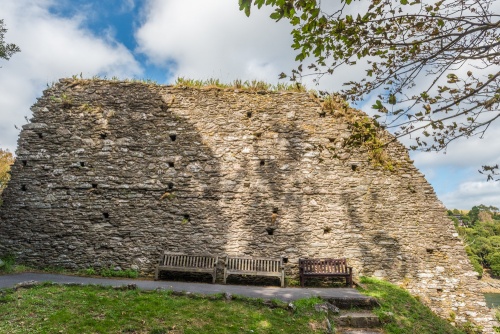
The fortalice was not finished until about 1403. Only one round tower survives, with a section of wall and a deep moat.
The Hundred Years War ended in 1453, but tensions between France and England remained high. It seemed likely that hostilities could resume at any time, so in 1462 when Edward IV urged the wealthy merchants of Dartmouth to strengthen their defences, they responded. The fact that Edward offered to contribute to the coast didn't hurt, either.
Even so, it took twenty years before work began in earnest to build a bulwark, a strongly defended artillery position with a heavy iron chain stretching across the river mouth to Kingswear Castle on the east bank.
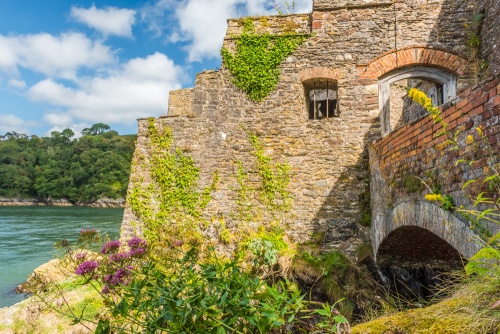
Work had not been completed in 1487 when Henry VII demanded that the burgesses of Dartmouth finish the work 'with all godly haste'. Even under pressure from the king, it was not until 1493 that work on the bulwark was finally completed. It seems that the design changed during construction, which is not surprising given how long it took to finish construction.
The result is a complex of linked buildings developed over a century, with gun positions, magazines, and watchtowers linked by underground passages. The final addition to the castle complex is the Victorian Point Battery, opened in 1861 to defend the River Dart with six powerful guns.
Sir Peter Carew
Dartmouth Castle was built and owned by the town of Dartmouth, but that changed in 1552. The Carew family owned the manor of Stoke Fleming, and Dartmouth Castle had been built on their land. The Carew's were a typical Tudor gentry family, proud of their family's importance and resentful of the power of Dartmouth's merchants.
In 1547 Lord Peter Carew became Lord of the Borough of Dartmouth and MP for the town. He used his position to seize Dartmouth Castle and oust the garrison, installing his own men in their place. Until his death in 1575 Carew administered Dartmouth Castle as his own property, despite the town taking him to court.
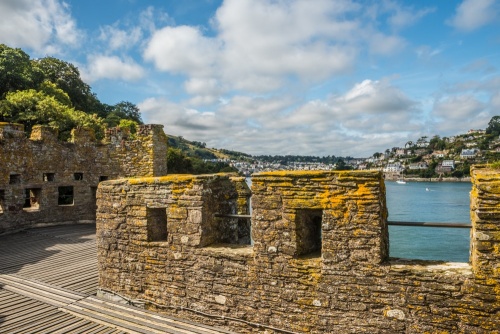
What to See
You enter the castle through the Guard Room, built over the main entrance. The Guard Room floor is pierced with circular murder holes directly over the entrance, used by guards to fire directly down on top of attackers.
From the Guard Room, you descend a spiral stair to a gun battery where you can see 18th-century guns in position to fire. One of these is a 24-pounder, built between 1787-1820. This gun had a range of just over one mile and could put a hole in the hull of a warship. There is also a 6-pounder carronade, to a design perfected at Falkirk in Scotland.
You can explore the lighting passage, where lamps were lit to illuminate the neighbouring magazine through heavy windows. Then there are the magazine rooms (where ammunition was stored) and casemates, enclosed chambers with positions for four guns. Two more heavy guns are on the upper floor.
You can also try on Tudor artillery helmets (they are very heavy!) and see a 17th-century Swedish gun.
Then there is St Petrox Church, dating back to the 12th century. The Church served as a place of worship for the soldiers of Dartmouth Castle.
Above the castle, a footpath leads through pleasant woodland to Gallants Bower, a Civil War fort built by the Royalist defenders of Dartmouth to defend the town and castle from attack by Oliver Cromwell's Parliamentarian army. Gallants Bower was briefly besieged in 1646 and promptly surrendered.
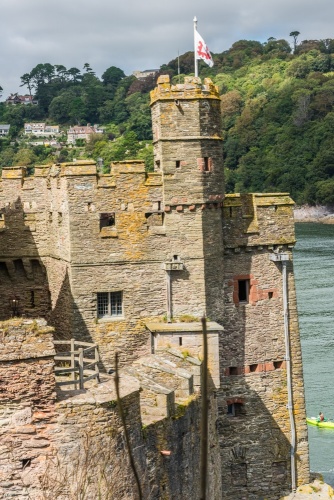
Getting There
Dartmouth Castle, which is now in the care of English Heritage, can be reached in three ways. The easiest - and possibly the most enjoyable way to arrive - is by a pedestrian-only ferry from the Dartmouth Embankment between Easter and the end of October.
The second, and longest way is to stroll along the Embankment to Bayard's Cove Fort, then follow the coast road to Warfleet and up Castle Road to the castle.
The third, and quickest way is by car, following the brown tourist signs up Castle Road to a parking area outside the castle. Be aware that the car park is small and does fill up on sunny days. You can sometimes find parking along Castle Road if you find the car park full.
Aside from its historical interest, the castle is popular as a picnic spot. Trails lead along the coast to the beach at Sugary Cove, and up through pleasant woodland to the Civil War fort of Gallant's Bower.
About Dartmouth
Address: Castle Road,
Dartmouth,
Devon,
England, TQ6 0JN
Attraction Type: Castle
Location: 1 mile south-east of Dartmouth, off the B3205
Website: Dartmouth
English Heritage - see also: English Heritage memberships (official website)
Location
map
OS: SX884504
Photo Credit: David Ross and Britain Express
HERITAGE
 We've 'tagged' this attraction information to help you find related historic attractions and learn more about major time periods mentioned.
We've 'tagged' this attraction information to help you find related historic attractions and learn more about major time periods mentioned.
Find other attractions tagged with:
NEARBY HISTORIC ATTRACTIONS
Heritage Rated from 1- 5 (low to exceptional) on historic interest
Dartmouth, St Petrox Church - 0.1 miles (Historic Church) ![]()
Gallants Bower Fort - 0.1 miles (Historic Building) ![]()
Bayard's Cove Fort - 0.5 miles (Historic Building) ![]()
Dartmouth, St Saviour's Church - 0.7 miles (Historic Church) ![]()
Dartmouth Museum - 0.8 miles (Museum) ![]()
Coleton Fishacre House and Garden - 1.5 miles (Historic House) ![]()
Greenway - 3 miles (Historic House) ![]()
Stoke Gabriel Church - 4.7 miles (Historic Church) ![]()
